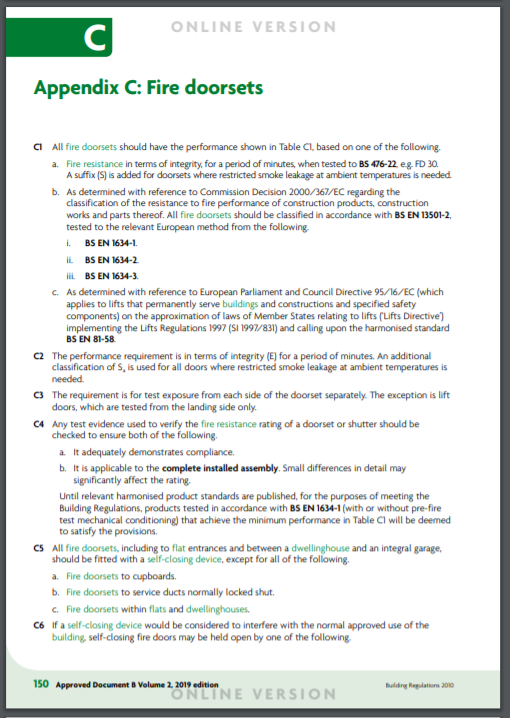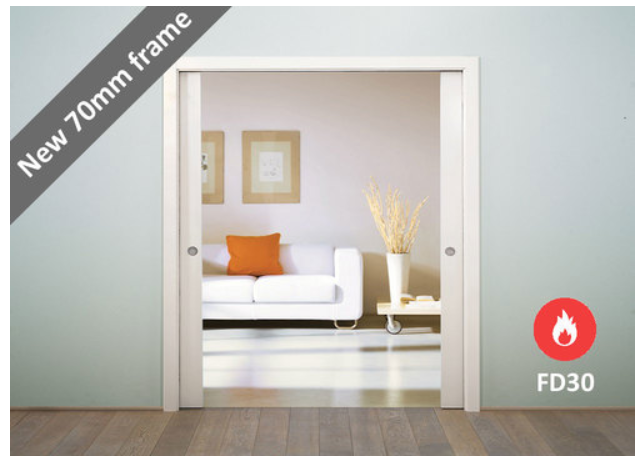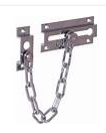-
Posts
427 -
Joined
-
Last visited
Everything posted by Neil ashdown
-

Making good a fire door after cutting into it
Neil ashdown replied to a topic in Fire Doors and Accessories
Use a small hand held bottle router with a trimmer bit. Failing that sand off the surplus. Make sure you use the correct adhesive for lipping the door leaf. -
It depends whether the door must also provide restricted smoke spread as well as fire resistance. Where there is a restricted smoke spread requirement the maximum gap is 3mm (refer to BS 8214:2016). For timber based fire doors and where there the is no such smoke requirement the maximum gap is generally between 6mm and 10mm, depending on the evidence of performance for the particular fire door. So it is very unlikely that a gap of more than 10mm will be compliant for any timber-based fire door. Where the 3mm gap requirement for restricted smoke spread cannot be met due to floor conditions, a threshold smoke seal / threshold plate will be required to close the gap accordingly.
-

Fire Door for Entrance to Private Flat
Neil ashdown replied to Flat Owner's topic in Fire Doors and Accessories
Composite fire doors are currently available for sale. With regard to the Government tests there's more information at https://www.gov.uk/government/publications/fire-door-testing-grp-composite-test-results -

space between fire door frame and opening
Neil ashdown replied to a topic in Fire Doors and Accessories
Yes. The architrave should not be relied upon to provide fire resistance. -

Making good a fire door after cutting into it
Neil ashdown replied to a topic in Fire Doors and Accessories
The contractor doing the remedial work to the fire doors does not have to possess any particular certification or qualifications BUT they must be COMPETENT. Refer to Article 17 and article 18 of the fire safety order. http://www.legislation.gov.uk/uksi/2005/1541/article/17/made http://www.legislation.gov.uk/uksi/2005/1541/article/18/made -

Fire Door Self-Closers - Angle of Release
Neil ashdown replied to Pacman's topic in Fire Doors and Accessories
? -

Fire Door Self-Closers - Angle of Release
Neil ashdown replied to Pacman's topic in Fire Doors and Accessories
Yes! When inspecting the self-closing function of a fire door, the inspector should check that the door self-closes from any opening angle.......fully-open to only-just-open. Suitable self-closing devices will have adjustment for latching action as well as closing speed. Any binding of the door on the floor covering, door frame, seals or latch strike plate etc. should be resolved before adjusting the controls of the self-closing device. For the self-closing device to function correctly it is necessary to install the closer-body at the correct position in relation to the door leaf for the required power-size (minimum size 3 for a fire resisting door) and install the closing-arm assembly in the correct location and arm configuration. This might be useful from 'Code of Pactice: Hardware for Fire & escape Doors' at http://www.firecode.org.uk/Code_of_Practice_hardware_for_fire_and_escape_doors.pdf -

Making good a fire door after cutting into it
Neil ashdown replied to a topic in Fire Doors and Accessories
Hi Adam, A drop seal will not be a substitute for a hardwood door lipping, in most cases. If you are installing a new fire door the installation instructions will state the maximum gap allowed at the threshold. This is usually somewhere between 6mm and 10mm from the bottom edge (the timber edge not the seal) of the door to the floor surface or threshold plate. It is necessary to comply to maintain the door's fire rating. Most fire doors are also required to provide smoke protection (at ambient temperature), in which case the maximum threshold gap is 3mm. If 3mm cannot be achieved due to floor conditions, then a static threshold seal or drop-seal will be required to close the gap, but the gap between the door bottom edge and the floor surface must still not exceed the door manufacturers requirements (eg. 6mm to 10mm). If the door is not new and the specific gap requirement unknown, work on a maximum gap of 10mm for a timber-based fire door and 3mm where smoke protection is required. If the gap is more than 10mm use a floor mounted threshold plate or suitably lip the door bottom edge with hardwood to reduce the gap accordingly. Then add a suitable threshold seal to provide smoke protection where necessary. See image below............... -

Flat fire door for private entrance
Neil ashdown replied to Nibarb's topic in Fire Doors and Accessories
Hi Andrey, Is this similar to the layout for your flat? But with just two bedrooms, one living room and one kitchen? -

Flat fire door for private entrance
Neil ashdown replied to Nibarb's topic in Fire Doors and Accessories
Reference to the document 'Fire Safety in Purpose Built Blocks of Flats' at https://www.local.gov.uk/fire-safety-purpose-built-flats will enable you to decide on the fire rating requirements for your internal doors. The requirement for the flat entrance door will be FD30(s) minimum and must be fitted with a suitable self-closing device. -

Fire Doors on Flat Conversion?
Neil ashdown replied to TopperUK's topic in Fire Doors and Accessories
In order for the doors to be installed as compliant, its better to replace the door frame for a number of reasons. A major one being that some timber-based fire doors have very limited scope for trimming the edges to fit existing frames. -
If the door is an entrance door to your flat and opens onto a common area inside the building, its most likely that the door you need will be rated FD30(s).
-

Does my front door need a lock without key?
Neil ashdown replied to a topic in Fire Doors and Accessories
Just to add that, there is a requirement that the lock-set is fire rated and installed in accordance with the fire door manufacturer's requirements. -
Use this search facility to find a fire door inspector https://fdis.co.uk/find-an-inspector-2/ Enter your post code to find local fire door inspectors.
-

Is it ok to rout a fire door to fit a seal
Neil ashdown replied to nwpattesting's topic in Fire Doors and Accessories
It is acceptable to router a groove in the top and vertical edges of the timber-based fire door leaf or leaves. The groove should be central to the leaf thickness except at the meeting edges of double door leaves where two offset seals may be a requirement. Do not fit a seal to a slave leaf that has flush bolts at its meeting edge, fit the seal to the main leaf instead. The groove must be only just large enough to accept the seals as a tight fit. Take care to make sure the groove is only just deep enough to suit the seal thickness as the seal must be flush with the door leaf edge. If you can find a BWF Certifire label (see below) on the door leaf you can refer to the CF certification data sheet for details about the type, configuration and size of seals required. If the groove will damage the BWF Certifire label, carefully remove it and reposition it alongside the groove. -

Are specific fire door gaps a legal requirement?
Neil ashdown replied to a topic in Fire Doors and Accessories
The standard for timber-based fire doors is BS 8214 and section 9.5.2 says: "Failure of fire resisting doors under test is very often due to burn-through at the operating gap between the door leaf edge and the door frame. A typical gap to achieve good fire performance is between 2mm and 4mm". So the question is: can you justify acceptance of gaps of slightly more than 4mm? 1) Are you happy to make a note in your Fire Risk Assessment that the fire doors have been inspected and that some of the gaps are non-compliant, but that you find this acceptable in certain circumstances? 2) Has the C.O.W. checked that the cold smoke seals are effective? An excessive gap will affect the smoke restriction performance of some types of cold smoke seal. 3) Could such non-compliancies have any impact on the safety of persons at the building in a fire? Post-Grenfell some flat entrance doors were tested by the Government and found to fail at 15 minutes rather than the required 30 minutes. This non-compliance was considered sufficient for the government to require that some fire door manufacturers cease production until further investigations were completed. -

Large single pocket fire door - DIY?
Neil ashdown replied to David Baker's topic in Fire Doors and Accessories
The requirements to comply with Building Regulations can be found at https://assets.publishing.service.gov.uk/government/uploads/system/uploads/attachment_data/file/832633/Approved_Document_B__fire_safety__volume_2_-_2019_edition.pdf Appendix C deals with fire doors and states that they must meet the required fire resistance requirement when tested to BS 476 - 22 or EN 1634 - 1. Therefore, as I understand the requirements, your bespoke design will need to be supported by documentary evidence. Fire door manufacturers will be able to provide you with maximum leaf dimensions and suitable configurations but I am not aware of a single leaf door that meets your specification. https://www.eclisse.co.uk/classic-double-fire-rated-pocket-door-system/ -

Fire doors in a domestic 3 storey house
Neil ashdown replied to a topic in Fire Doors and Accessories
Clearly, keyless egress is a useful life protection measure in an emergency scenario. If you need to open the door in an emergency and the key is not to hand that could increase the risk to life safety. However, my understanding is that in England & Wales, the Fire Safety Order 2005 does not apply inside your own private home. Check at http://www.legislation.gov.uk/uksi/2005/1541/contents/made and you could check Building Regs at https://www.gov.uk/government/publications/fire-safety-approved-document-b Or you could retain the keyless egress but use a security chain to help restrict the door being opened, when it shouldn't. -
I would advise you to consult a local building regulations expert on this matter. In the meantime, this may be useful? https://www2.gov.scot/resource/buildingstandards/2016Domestic/chunks/ch03.html But check for recent updates!
-

Fire Door - need a self-closer?
Neil ashdown replied to MysteryMan's topic in Fire Doors and Accessories
I would advise you to consult a local building regulations expert on this matter. In the meantime, this may be useful? https://www2.gov.scot/resource/buildingstandards/2016Domestic/chunks/ch03.html This may be useful? http://www.doorfingerprotector.co.uk/ -
Detail below illustrates accepted method for door frame / lining extension to suit wider walls. Generally, FD30 door frames may be softwood minimum density 450kg per cu mtr and for FD60 hardwood 640kg per cu mtr (at 15% moisture content). Generally door fame thickness minimum 32mm plus the rebate stop by 70mm minimum width. Hope this helps.
-
Think this a new product? Saw one like it on Twitter the other day. The correct answer to your question is that the product manufacturer should be consulted to check that a fire performance test, (to BS 476-22 or EN 1634-1) has been carried out and that the product did not adversely affect the door in that test. Alternatively, where you have the door leaf manufacturers details you can check with them to see if they permit the fitting of this device without any conflict with the door's fire performance. Assuming you have none of the above, then proceed with caution and consider the following: 1) Could fitting this product to the door leaf increase the risk of accidental foot injury? 2) Could fitting this product compromise the fire performance of doors that have a metal face protection plate (by holding the plate against the door rather than allowing the plate to fall away in a fire)? From a fire safety angle my own view on this product, bearing in mind that I haven't yet seen one, is that due to the fact that the product would most likely be positioned at the face of the door very near to the bottom edge with short screw fixings it is unlikely to have a great affect on fire resistance performance. There would be a question about the durability of the product in terms of how well the screws perform in providing a secure fixing in the longer term. Clearly, bolt-through fixings would be more durable but are more likely to affect fire performance, particularly where a metal plate has been fitted to the face of the door.
-
Thank you Bob, glad to be of use. I will do my best to take your questions one by one.............. ArchitraveArchitrave is fitted to the door frame surround, but my reading of the door certificate and test report, and other documentation seems not to give definitive credance to the protection provided by the architrave, almost suggesting that the test results should be viewed as if Architrave is not fitted, yet other writings suggest a 19mm thick architrave does provide some protection.Could I draw from this that, as archtrave comes in many differing styles (Ovolo, ogee, Torus etc etc) the thickness of these at the point of nailing (and gap covering) is often less than 19mm, usually nailed with thin panel pins, and a softwood, so its not always viewed as offering reliable protection ... and hence the need for mastic in any gaps behind.A: Fire doors are fire resistance tested without architraves fitted. Generally, for the reasons you state, the architrave should not be relied upon as a contributor to fire performance. Clearly, though, where architraves are securely fitted as described in BS 8214 they would likely enhance the fire resistance performance of the door. Building ControlHow much should you rely on Building Control to advise on fire protection in a buildings fabric, if you seek approval from them for a specific solution to a problem (ie pentrations through a 60 minuite ceiling, and glass in a 60 minute wall), and they approve your proposal, and it is installed correctly, can you be confident they will advise correctly, or should you seek more specialised advice. I am using a large national private Building Control company. A: The Building Control officer may not be a specialist in passive fire safety, their job is to see that the works meet the requirements of the Building Regulations. With that in mind, I am of the opinion that it is better and safer to consult a specialist to advise on a particular fire resistance issue. Fire Protection Details.Is it normal for an architect to advise on Fire matters with Fire Protection Details on BC plans, or should one look to Building Control to advise, do Building Control look over plans prior to works and over rule/make additional direction on Fire matters to that of the architect. A: Sorry, I can't answer that one as it's beyond the level of my experience in Building Control matters.
-

fire door seals: with or without brush
Neil ashdown replied to a topic in Fire Doors and Accessories
The Fire Risk Assessment for the building should state whether a fire door is required for that room. What is the risk of fire starting in that room? What would be the risk to others were a fire to start in that room? What measures can be taken to deal with and mitigate the effects of a fire starting in that room? -

Do I need to use special paint on new fire doors?
Neil ashdown replied to a topic in Fire Doors and Accessories
'BS 8214:2016 Timber-based fire door assemblies - Code of practice' places no restrictions on the type of paint or lacquer in terms of the fire resistance performance of the door. The issue with paint or lacquer is that build up of layers of oil or solvent based paint or lacquer may increase the rate of the spread of flames across a surface in a fire. Surface spread of flame is very different to the fire resistance of a door so when painting doors, walls and ceilings take account of the use of the building in terms of surface fire spread considerations. Surface spread of flame test: Fire door test: https://www.bing.com/videos/search?q=fire+door+test+video&docid=608028868971005737&mid=59C8261F1AE9C29E9A9359C8261F1AE9C29E9A93&view=detail&FORM=VIRE









